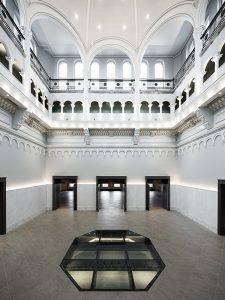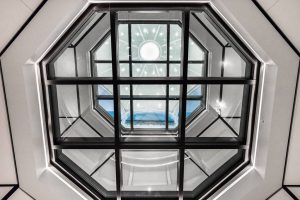
Photos courtesy Technical Glass Products
Constructed in 1899, the historic Fayette County Courthouse was once the shining jewel of Lexington, Kentucky, but over the years, it became old and rundown. With the help of fire-rated glass floor systems the courthouse was restored and is once again the centerpiece of the town.
The Richardsonian Romanesque-style building was one of the first fully electrified structures in the city. Its central dome used electric lighting to create a star-like ceiling visible to occupants from the ground-floor entrance. But in the 1960s, this one-of-a-kind viewing experience changed.
A new central elevator shaft and heating and air-conditioning equipment obscured views of the dome and prevented it from streaming daylight throughout the building.
As a local newspaper reported, “Over the next 60 years, the dome area deteriorated and became home to pigeons and other birds. Only courthouse and maintenance staff—and the occasional reporter—saw the dome.”
The building remained in this declining state until 2002, when it was vacated. The city eventually shut down the courthouse in 2012 due to concerns about deterioration and asbestos hazards.
Unwilling to let such a historic building go to waste, the City of Lexington hired K Norman Berry Architects, in conjunction with Deborah Berke Partners, to convert the courthouse into a modern mixed-use office and restaurant space, with leasable event rooms in the upper rotunda.
 According to K Norman Berry Architects, the goal was to “preserve the character of the building, especially its existing architectural fabric, while updating it for a new mix of uses to once again make the building an accessible and dynamic focal point of [the city’s] downtown.”
According to K Norman Berry Architects, the goal was to “preserve the character of the building, especially its existing architectural fabric, while updating it for a new mix of uses to once again make the building an accessible and dynamic focal point of [the city’s] downtown.”
During this process, a key point of emphasis was restoring the building’s original domed area. The design team reconstructed the plastered interior of the dome and added lighting to evoke a starry sky. To spatially connect the lower floors to the upper domed space while bringing the building up to current fire- and life-safety building codes, they specified two fire-rated glass floor systems. The fire-rated glass floor systems were centered and aligned under the dome on the third and fourth floors.
To meet the requisite needs of the space, the fire-rated glass floor systems consisted of fire-rated glass; a tempered, laminated walking surface glass, and a steel framing grid. The systems are fire-rated for two hours and provide a barrier to flames and smoke, as well as radiant and conductive heat. In the event of a fire, this ensures their surface remains cool enough for individuals to walk across for the duration of their two-hour fire rating.
In application, the code-compliant fire-rated glass floor systems transfer daylight into the center of the building, while also allowing lower-floor occupants to glimpse the grandeur of the dome. To enhance the viewing experience, the fire-rated glass floors feature a ceramic frit on the top (floor side) of the glass. It creates a sparkly appearance enhancing the starry sky lighting in the remodeled dome, while also functioning as a durable non-slip walking surface. To account for safe pedestrian use, the fire-rated glass floor systems support loads up to 732 kg/m2 (150 psf).




